Schroeder Diffuser
July 24, 2017
Many an
animated cartoon has used the "echo canyon" joke in which a person shouting a word, or a short phrase, first hears an
echo of his
voice, then hears a response to a later phrase. There's an
Echo Canyon State Park near
Pioche, Nevada, and various other echo canyons in the
United States, including one in
Zion National Park near
Springdale Utah.
The Simpsons, when aired in short segments on
The Tracey Ullman Show, had an Echo Canyon short, March 12, 1989.[1-2]
There's even a
mathematics-
themed echo canyon
joke, as follows.[3] The interesting thing about this joke is that "
string theorist," or a few other
scientific professions, could be used in place of "
mathematician."
Three men are in a hot-air balloon, and they found themselves lost in a canyon, somewhere. One of the men says, "I've got an idea. We can call for help in this canyon, and the echo will carry our voices far." So, he leans over the basket and yells out, "Helllloooooo! Where are we?"
(They hear the echo several times).
Fifteen minutes later, they hear this echoing voice: "Helllloooooo! You're lost!!"
One of the men says, "That must have been a mathematician." Puzzled, one of the other men asks, "Why do you say that?"
"Three reasons. (1) he took a long time to answer, (2) he was absolutely correct, and (3) his answer was absolutely useless."
Recorded music was increasing in
popularity in the
1950s, and that gave rise to many
garage recording studios having
primitive equipment and a single
ribbon microphone as a centerpiece. To prevent recordings from sounding like they were made in an empty
closet, the
audio engineers needed some
inexpensive ways to prevent echos from the
walls and
ceilings. One technique was to hang
blankets. Another was to use inexpensive
acoustic absorbers, as shown in the photo.
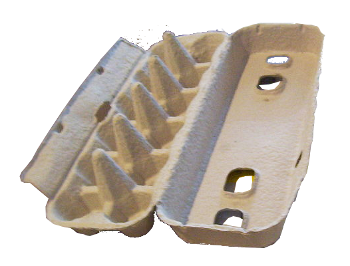
The left part of this cardboard egg carton would make a fine acoustic absorber. Quite a few of these would be needed to cover the walls and ceilings of a recording studio. Unless treated, these would be a fire hazard.
(photo by Dfrg.msc (Nicolas), modified, via Wikimedia Commons.
Most of us have witnessed how the echo in
rooms of an empty
house or
apartment is extinguished once the
furniture is in place. The
soft fabrics of furniture and
carpets, and the irregular surfaces of the furniture are good at preventing echos. Some rooms, such as
auditoriums, are necessarily large, unfilled
volumess.
Surface appliances have been developed to prevent echos in such rooms (see photo). The general idea is to makes these from a sound-absorbing
material, and
form the surfaces in a way that residual
reflections are
diffused.
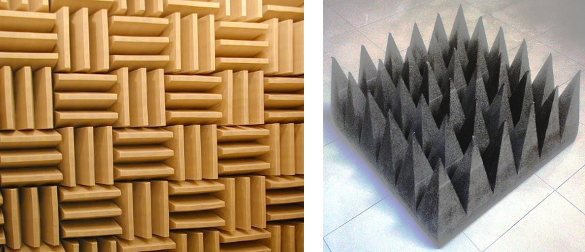
Left, an anechoic chamber at Yokosuka Research Park, Japan. Right a radar absorbing surface. The principles of radar wave absorption and acoustic wave absorption are similar. (Left image by Jpatokal; right image by Togabi; both via Wikimedia Commons.
In 1975, noted
German physicist,
Manfred R. Schroeder (1926-2009), published a
design for an acoustic diffuse reflector.[4] The Schroeder diffuser has been used quite often since that time for both
architectural and
technical applications. One requirement for such structures that depend on modification of the
phase of the
reflected wave, including
radio antennas, is the requirement that the size of the elements is on the order of the
wavelength, which is large for most
audio frequencies. There are many
YouTube videos showing how to build a Schroeder diffuser.[5-7]
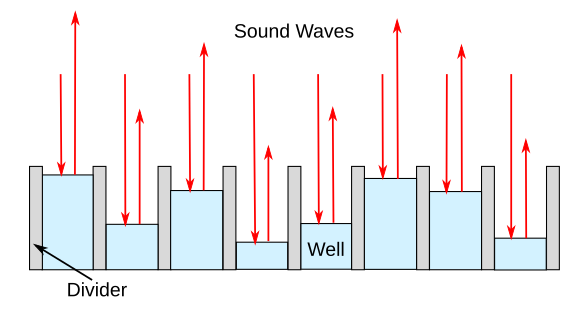
As they say, "It's all done with mirrors." The varied heights of the reflecting surfaces in a Schroeder diffuser create phase shifts that cause reduction in the intensity of the acoustic wave. (Created with Inkscape.
Now, physicists and
engineers at
Nanjing University (People's Republic of China) and
North Carolina State University (Raleigh, North Carolina) have tackled the problem of the diffuser's size being of the order of a wavelength.[8-9] For a Schroeder diffuser, the element depth must be about half the wavelength of the lowest frequency; and, for a
male speaker, this is 85 Hz, for a half-wavelength of eighty
inches.[9] They've used a
metamaterial concept to make a metasurface that reduces the dimension by a factor of ten.[8-9]
This is the first use of a metasurface as a sound diffuser.[8] The diffuser is an
array of evenly spaced
square chambers having varied
aperture.[9] The apertures are designed to introduce phase shifts into the reflected sound waves, the same principle on which the Schroeder diffuser is based. The
research team used
numerical simulation, and they created
3D-printed diffusers of an
acrylonitrile-butadiene-styrene plastic.[8]
Experiment showed that the metasurface diffuser worked as well as a Schroeder diffuser.[8]
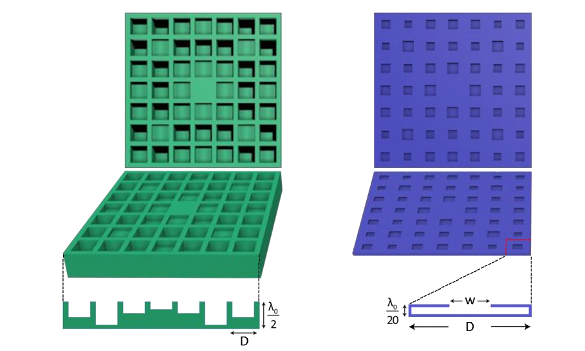
A conventional Schroeder diffuser is shown on the left, and the metasurface diffuser is shown on the right.(NCSU image.
Says
Yun Jing, an
assistant professor of
mechanical and aerospace engineering at NCSU and an
author of the
paper that describes this work,
"Diffusers are often made out of wood, so our design would use 10 times less wood than the Schroeder diffuser design... That would result in lighter, less expensive diffusers that allow people to make better use of their space... We've built fully functional prototypes using a 3-D printer, and it works... The design should work just as well using wood."[9]
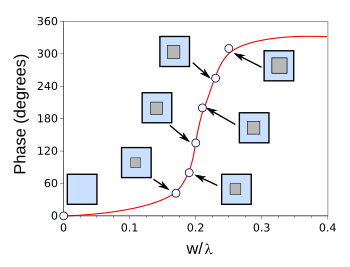
Phase shift as a function of aperture dimension for the metasurface acoustic diffuser.
(Data from Ref. 8, graphed using Gnumeric.[8]
![]()
References:
- Echo Canyon, Simpsons Wiki.
- Echo Cannyon, YouTube Video by The Simpsons Shorts, June 27, 2016.
- Math Jokes Page of Zachary S. Tseng, Pennsylvania State University Math Department Web Site. The joke can be found in many places, such as here, here, and here.
- M. R. Schroeder, "Diffuse sound reflection by maximum−length sequences," The Journal of the Acoustical Society of America, vol. 57, no. 1 (1975), pp. 149 ff., doi: http://dx.doi.org/10.1121/1.380425.
- How to build an acoustic diffuser, YouTube Video by TheDSPproject, May 7, 2013.
- Calculate Skyline Diffusor, based on research by R. Walker, Engineering Division of the British Broadcasting Corporation.
- Do-it-Yourself Acoustical Treatment: How to Build a Diffuser, YouTube Video by FocalOnline (Peter Johnson), May 10, 2012.
- Yifan Zhu, Xudong Fan, Bin Liang, Jianchun Cheng, and Yun Jing, "Ultrathin Acoustic Metasurface-Based Schroeder Diffuser," Phys. Rev. X, vol. 7, no. 2 (June, 5, 2017) Article No. 021034, DOI:https://doi.org/10.1103/PhysRevX.7.021034. This is an open access article with a PDF file here.
- Matt Shipman, "New Sound Diffuser Is 10 Times Thinner Than Existing Designs," North Carolina State University Press Release, June 6, 2017.
Permanent Link to this article
Linked Keywords: Animated cartoon; echo; human voice; Echo Canyon State Park; Pioche, Nevada; United States; Zion National Park; Springdale Utah; The Simpsons; The Tracey Ullman Show; mathematics; theme; joke; string theory; string theorist; science; scientific; profession; hot-air balloon; canyon; idea; distress signal; call for help; gondola; basket; sound recording and reproduction; recorded music; popular culture; popularity; 1950s; garage; recording studio; primitive; electronics; equipment; closet; cost; inexpensive; wall; ceiling; blanket; acoustic; acoustic foam; absorber; cardboard; egg carton; fire retardant; treated; fire safety; fire hazard; Dfrg.msc (Nicolas); Wikimedia Commons; room; house; apartment; furniture; textile; soft fabric; carpet; auditorium; volume; attachment; surface appliance; material; form; reflection; diffusion; diffuse; anechoic chamber; Yokosuka Research Park, Japan; radar; absorption of electromagnetic radiation; acoustic wave; Jpatokal; Germany; German; physicist; Manfred R. Schroeder (1926-2009); design; architecture; architectural; technology; technical; phase; reflected wave; radio antenna; wavelength; audio frequency; YouTube video; It's all done with mirrors; phase shift; intensity; Inkscape; engineer; Nanjing University (People's Republic of China); North Carolina State University (Raleigh, North Carolina); male; inch; metamaterial; array; square; aperture; research; computer simulation; numerical simulation; 3D printing; 3D-printed; acrylonitrile-butadiene-styrene; plastic; experiment; metasurface; Yun Jing; assistant professor; mechanical and aerospace engineering at NCSU; author; scientific literature; paper; wood; prototype; dimension; Gnumeric.